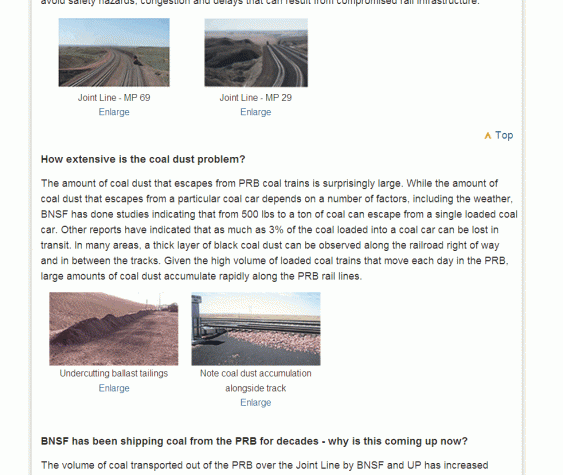Coal dust is a problem for railways. It escapes from rail cars during shipping, creating safety and congestion problems. It’s toxic, unhealthy, and obviously unpopular with nearby communities.
And yet… coal is the single biggest source of revenue for freight railways. So when debate about new export terminals turns to coal dust, what’s a railroad to do? According to BNSF—shipper of Powder River Basin coal to the Northwest—the answer is: scrub your website.
They recently removed some important information about coal dust. Fortunately, I can right-click like nobody’s business. So, for the sake of posterity and public policy alike, I give you a screenshot of the original version of BNSF’s guide for freight customers, “Coal Dust Frequently Asked Questions.”
You read that right. BNSF says that “500 pounds to a ton of coal can escape from a single loaded car.” Coal dust accumulates in the ballast between the rails, undermining the track structure and causing derailments. And coal dust deposits sometimes even cause fires.
In addition to what BNSF once acknowledged on its website, the US Department of Transportation classifies coal dust as a “pernicious ballast foulant” that can weaken and destabilize rail tracks. Although there are ways to reduce or eliminate coal dust escaping during transit—such as reducing the amount of coal per car or covering loads with tarps or sprayed-on chemical sealants—the measures are unpopular with coal shippers because they add to the cost of moving coal. It will be interesting to watch how this issue plays out now that BNSF won a ruling from the Surface Transportation Board (STB) that will require coal cars to reduce coal dust escape, perhaps by as much as 85 percent.*
Assuming that the new rules can be enforced, the coal dust problem may be limited to “only” 75 to 300 pounds of coal dust settling on nearby communities. Too bad it’s potentially 300 pounds per rail car, and rail line communities between the Powder River Basin and Washington ports are looking at perhaps 18 trains per day, each of them roughly 125 cars long.


Comments are closed.